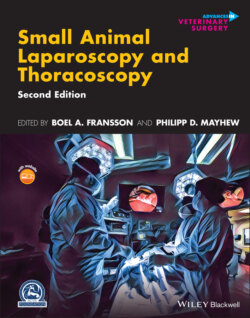Читать книгу Small Animal Laparoscopy and Thoracoscopy - Группа авторов - Страница 161
Respiratory Effects
ОглавлениеRespiratory function is also altered during laparoscopic intervention. The increase in abdominal pressure and volume limits diaphragmatic excursion and reduces pulmonary compliance, functional residual capacity, and vital capacity of the lung and may lead to ventilation/perfusion mismatch [42, 48,71–73]. Hence, it is not surprising that the effects tend to be proportional to insufflation pressures as is shown in young swine [74] and adult dogs [48, 75]. In spontaneously breathing dogs, respiratory rate remained unchanged with abdominal insufflation, but a significant reduction in tidal volume was reported [75]. With volume‐controlled ventilation maintenance of tidal volume results in an increase in peak inspiratory pressure [48], and hypercapnia and hypoxemia might still occur. Similarly, when using pressure‐controlled ventilation, the peak inspiratory pressure must be increased, to overcome the decrease in lung compliance and avoid a reduction in tidal volume. The resulting positive pressure in the chest has an additional impact on reducing venous return and thus cardiac output could be further compromised.
In spontaneously breathing animals, the decrease in tidal volume and increase in end‐tidal carbon dioxide are proportional to increasing insufflation pressure and the negative impact lasts longer in animals exposed to the higher pressures [75]. This reflects fatigue on the part of the patient and has led to the common recommendation for mechanical ventilation in patients in whom the procedure is anticipated to last longer than 15–30 minutes.
The inability for a patient to compensate for the elevation in CO2 by adjusting their ventilation is even more notable when CO2 is used as the insufflation gas as is common practice. This is because CO2 is highly diffusible and enters the blood stream contributing to a rise in arterial tension. Hence, the impact on ventilation is greater than insufflation with an inert gas, such as helium, or with other gases such as nitrous oxide (N2O) or air (albeit those gases have other disadvantages) [76–78]. An increase in arterial CO2 tensions may initially be cardiovascularly supporting [41, 76], but will ultimately result in a concurrent decrease in blood pH which in turn has a potential to impact cellular metabolic processes. The cardiac rhythm may also be affected by the increase in CO2 tensions and resulting acidosis and increased sympathetic tone, which can lead to tachycardia, premature ventricular contractions, and in rare occasions ventricular tachycardia and fibrillation [79].
Elevated CO2 tensions are also associated with increased cerebral blood flow [80, 81], but additional mechanisms may exist [82]. In compromised patients or those breathing a low inspired oxygen tension, excessive CO2 levels may contribute to hypoxemia. In addition, CO2 tensions greater than 90 mmHg have anesthetic effects in their own right [83].
As for the cardiovascular system, additional factors such as positioning may further impact respiratory effects [32, 71, 72, 84]. Both Trendelenburg and reverse Trendelenburg positions have a negative impact on lung expansion due to increased lung and chest wall impedance [85]. The observed decrease in lung compliance and volumes, such as functional residual capacity and total and vital lung capacity [71, 72, 86, 87], leads to further increase in CO2 tensions [87–90]. Therefore, the use of mechanical ventilation is important to maintain CO2 levels within acceptable limits and to avoid decreases in arterial oxygen tensions [88, 91]. In animals and in humans, the Trendelenburg position is associated with greater respiratory depression, particularly regarding oxygenation [72, 85, 88, 92]. These respiratory effects seem to be species dependent with dogs and cats less impacted than horses and sheep. In addition, horses with a higher body weight seem to be more affected, with higher arterial CO2 and lower oxygen tensions [92].
